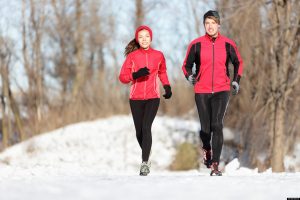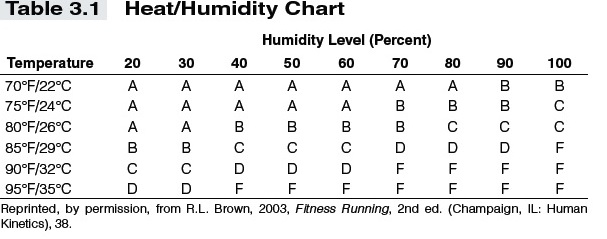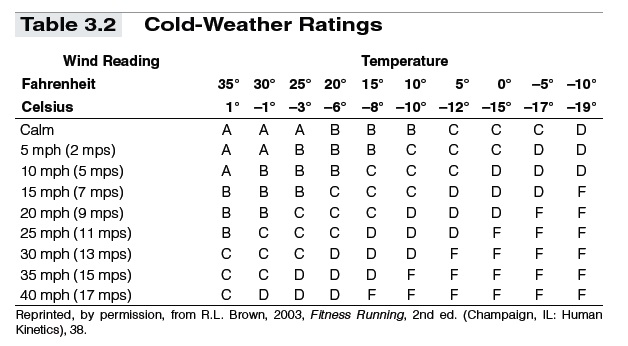Weather variations make any outdoor activity, including walking, more complicated and layers more important. Of course, it’s also the weather that makes being outdoors a lot more enjoyable too, as long as you correctly layer the right protective gear and apparel. In cold weather, try to pick a warmer part of the day for your workout and the warmest days for your harder walks. Cover your ears, nose, and fingertips; these parts of your body are most susceptible to frostbite. If you’re particularly susceptible to the cold, carry extra sweats or an oxygen-activated heat pack for after your workout (these are little carbon- filled bags that, when opened, become cozy hand warmers that produce heat for about eight hours). Remove sweaty, wet clothing as soon as possible after your workout because the moisture will continue to draw heat from your cooling body. Be aware of the early signs of frostbite (tingling, numbness, or burning in the extremities) or hypothermia (pallor, mental confusion, or cold extremities).
Hot climates are always a challenge, particularly because humidity can make a difference in effort and potential danger. Wear white  clothing, which better reflects the hot sun. Even lightweight, loose, long-sleeved, white shirts can reflect heat better than bare arms. Try soaking a hat in cool water before wearing it, and punch holes in it so your body heat can escape. Drink plenty of water before and after your workout, and don’t be afraid to sweat. Sweat acts as your body’s natural evaporative air cooler. Stay alert for signs of heat exhaustion and heatstroke: weak or rapid pulse, headache, dizziness, weakness, lack of sweating, and hot and dry skin. Normally you need a week or two to get used to the heat. But that means you have to go out for easier walks, not sit on the porch sipping iced tea. Just take it easy when it first gets hot and avoid the hottest part of the day. You can also consider finding a mall or gym where you can walk indoors on extremely cold or hot days.
clothing, which better reflects the hot sun. Even lightweight, loose, long-sleeved, white shirts can reflect heat better than bare arms. Try soaking a hat in cool water before wearing it, and punch holes in it so your body heat can escape. Drink plenty of water before and after your workout, and don’t be afraid to sweat. Sweat acts as your body’s natural evaporative air cooler. Stay alert for signs of heat exhaustion and heatstroke: weak or rapid pulse, headache, dizziness, weakness, lack of sweating, and hot and dry skin. Normally you need a week or two to get used to the heat. But that means you have to go out for easier walks, not sit on the porch sipping iced tea. Just take it easy when it first gets hot and avoid the hottest part of the day. You can also consider finding a mall or gym where you can walk indoors on extremely cold or hot days.
Heat–Humidity Readings
Keep the following hot-weather ratings table handy for reference on hot days (see table 3.1). Find the temperature on the left side of the scale and the relative humidity percentage on the top. Find where these two readings converge. A temperature below 75 degrees Fahrenheit is normally always safe (“A” ratings), and one above 95 degrees is almost always unsafe (“F” ratings), no matter what the humidity. Use good judgment when ratings fall from “B” to “D.” The typical advice is to exercise outdoors during cooler morning hours, but that doesn’t necessarily hold true in humid climates. When it’s warmer, such as in the late evening in humid areas, the air has a higher moisture-holding capacity, so the same amount of moisture in the air will result in a lower overall relative humidity.

Wind-Chill Readings
Use the cold-weather ratings table for windy winter days (see table 3.2). Locate the day’s wind speed on the left side of the scale and the temperature across the top. Find where these two readings converge. A temperature above 35 degrees Fahrenheit is normally always safe (“A” ratings), and one below 10 degrees below zero is almost always unsafe (“F” ratings), no matter what the wind speed. Again, use good judgment when ratings fall from “B” to “D.”

Post Views: 305